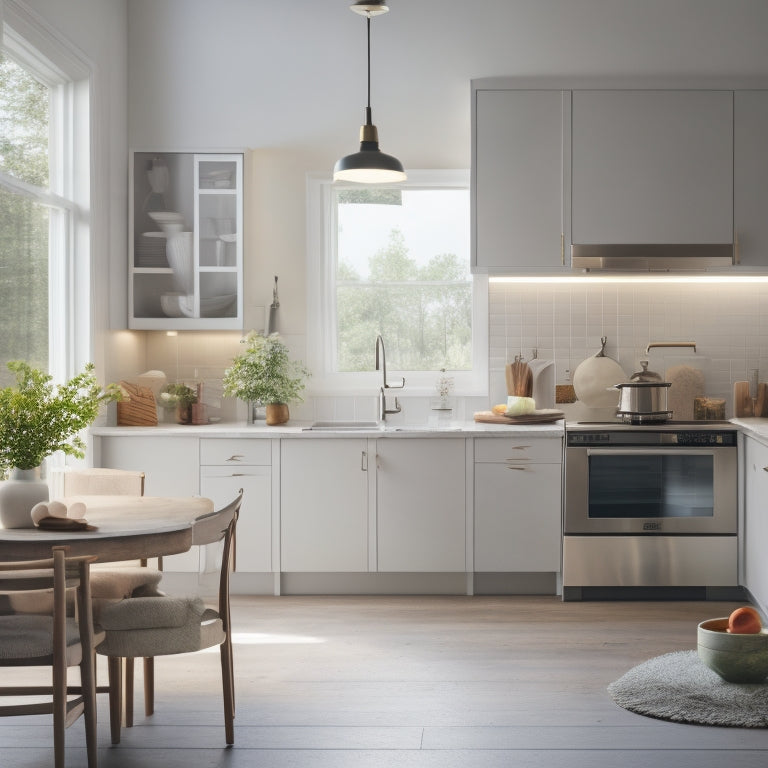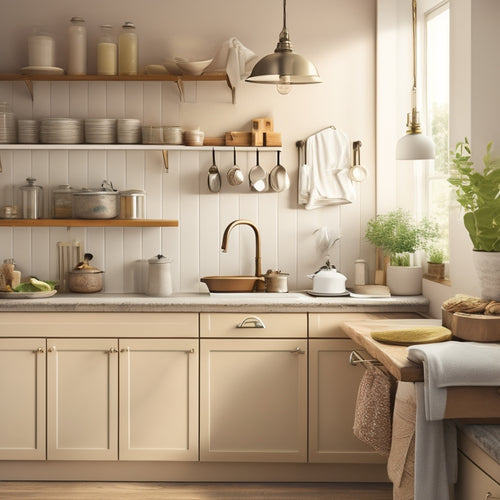
Declutter Your Kitchen With These Free Online Guides
Share
You're about to transform your kitchen into a clutter-free sanctuary with the help of these extensive online guides. Start by gathering essential supplies and setting aside dedicated time to focus on decluttering. Learn how to sort items into three piles, utilize organization tips, and clean as you go. Discover kitchen organization strategies, such as assigning a home for each item in the pantry and categorizing food in the fridge into zones. Get meal planning tips, like mapping out meals for the week and making a grocery list. Immerse yourself in tackling clutter hotspots, maximizing storage space, and creating a maintenance routine. Get ready to access a more efficient, stress-free kitchen - the secrets to achieving it are just ahead.
Key Takeaways
• Gather essential decluttering supplies, set aside dedicated time, and start small to tackle kitchen clutter.
• Assign a home for each item in the pantry, categorize food in the fridge, and utilize vertical storage to maximize space.
• Sort items into three categories: keep, donate/sell, and discard, and purge expired items to declutter hotspots.
• Use labels, dividers, and baskets to organize similar items together and maintain a clutter-free kitchen.
• Map out meals, plan ahead, and consider meal prepping to avoid last-minute takeout and reduce kitchen clutter.
Decluttering Essentials for Beginners
Start by gathering essential supplies, like sturdy boxes, trash bags, and a marker, to tackle the overwhelming task of decluttering your kitchen. You'll need these basics to sort, categorize, and purge items that are no longer serving you.
Next, set aside dedicated time to focus on decluttering, free from distractions and interruptions. This will help you stay committed to the task at hand and make decisions quickly.
As you begin, remember these decluttering tips: start small, work in sections, and sort items into three piles - keep, donate/sell, and discard. Be ruthless about getting rid of items that are broken, expired, or haven't been used in the past year.
Utilize organization hacks like categorizing similar items together and assigning a home for each item to maintain order. Don't forget to clean as you go, wiping down surfaces and dusting shelves to reveal the newly decluttered space.
Kitchen Organization Strategies
Now that you've decluttered your kitchen, you're ready to implement strategic organization systems that will maintain your newly gained space and efficiency. It's time to create a system that works for you, not against you.
Start by tackling your pantry organization. Assign a home for each item, and use baskets, bins, and labels to keep similar items together. This will make meal prep a breeze and reduce food waste.
Next, give your fridge a makeover. Purge expired or spoiled items, and categorize your food into zones (e.g., dairy, meats, veggies). Use the 'first in, first out' rule to guarantee you consume older items before they expire. Install shelves, baskets, or hooks to maximize vertical space and keep frequently used items within easy reach.
Meal Planning Made Easy
By mapping out your meals for the week, you'll save time, reduce food waste, and guarantee that you're cooking dishes that align with your dietary goals and preferences.
With a clear plan, you can avoid last-minute takeout or dining out, which can be costly and unhealthy. Start by reviewing your schedule for the week and identifying the number of meals you need to prepare.
Then, browse through your recipe collection and select dishes that fit your dietary needs and the ingredients you already have on hand. Make a grocery list of the items you need to purchase and stick to it when you're at the store.
Consider meal prepping on the weekends or one day a week to make the most of your time. With a solid meal plan in place, you'll be more efficient, reduce waste, and enjoy healthier, more delicious meals.
Tackling Kitchen Clutter Hotspots
With your meal planning strategy in place, you're likely to notice that certain areas of your kitchen are still cluttered, making it difficult to efficiently prepare the meals you've planned. It's time to tackle these kitchen clutter hotspots head-on.
Identify the areas that need attention, such as your pantry, fridge, countertops, and sink. Take a closer look at each area and sort items into three categories: keep, donate/sell, and discard.
Here are some specific tips to get you started:
| Area | Task |
|---|---|
| Pantry | Purge expired items, organize by category (e.g., baking, snacks), and use storage bins |
| Fridge | Remove expired or spoiled food, wipe down shelves, and organize by meal prep category (e.g., breakfast, lunch, dinner) |
| Countertops | Clear off clutter, designate a "launching pad" for daily essentials, and consider a utensil organizer |
| Sink | Clean and declutter the sink area, and consider installing a soap dispenser and sponge holder |
| Cabinets | Remove unused items, organize by category (e.g., cooking, baking), and consider using dividers or baskets |
Maximizing Storage Space Solutions
Take inventory of your kitchen's storage capacity and pinpoint areas where you can optimize storage solutions to keep your newly decluttered spaces organized.
Identify the 'dead zones' in your kitchen, such as the space above your cabinets or the area beneath your sink, and brainstorm creative ways to utilize them. Consider installing shelves, hooks, or baskets to maximize vertical storage and keep frequently used items within easy reach.
Next, implement space-saving hacks like the 'zone defense' strategy, where you group similar items together to reduce clutter and increase efficiency. For instance, designate a specific area for baking supplies, and store them in airtight containers or baskets to keep them organized and easily accessible.
Additionally, incorporate organization tips like labeling your storage containers and categorizing your kitchen items to maintain a sense of order and structure. By optimizing your kitchen's storage capacity, you'll create a more streamlined and efficient cooking environment that makes meal prep a breeze.
Creating a Maintenance Routine
Now that your kitchen is decluttered and storage-optimized, it's time to establish a routine to maintain this new order and safeguard it doesn't slide back into chaos. You've worked hard to get your kitchen in shape, and with a solid maintenance routine, you'll be able to enjoy the benefits of a clutter-free space for the long haul.
To create a routine that sticks, start by identifying the tasks that need to be done daily, weekly, and monthly. Make a schedule and stick to it. Consistency is key when it comes to maintaining your kitchen's new order.
Set aside a few minutes each day to wipe down countertops, put away dishes, and tidy up after meals. Weekly tasks might include cleaning the fridge and oven, while monthly tasks could include deep cleaning the pantry and reorganizing storage spaces.
Overcoming Common Decluttering Obstacles
Overcoming Common Decluttering Obstacles
Four common obstacles often derail even the best decluttering efforts: sentimental attachment to items, lack of time, physical or mental fatigue, and uncertainty about where to start. You're not alone if you've faced these challenges. The good news is that you can overcome them with the right strategies.
Here are some tips to help you overcome common decluttering obstacles:
-
Set a timer: Allocate a specific time slot for decluttering, and stick to it. This will help you stay focused and avoid burnout.
-
Let go of emotional attachment: Remind yourself that the memories are what's important, not the item itself. Take a photo of the item and let it go.
-
Break it down: Divide your decluttering task into smaller, manageable chunks. This will help you make progress without feeling overwhelmed.
-
Get support: Share your decluttering goals with a friend or family member and ask for their support.
-
Celebrate small wins: Acknowledge and celebrate your progress, no matter how small. This will help you stay motivated and encouraged.
Frequently Asked Questions
How Do I Get My Family on Board With Kitchen Decluttering?
You'll get your family on board with kitchen decluttering by communicating the benefits, motivating them with a shared goal, overcoming resistance with empathy, and setting boundaries to maintain the new space, ensuring a harmonious and organized kitchen.
Can I Declutter My Kitchen Without Throwing Away Sentimental Items?
You can declutter your kitchen without ditching sentimental items by using organizing tips that respect emotional attachments; create a "maybe" box, take photos, and repurpose items to ease the decluttering process.
Do I Need to Purchase New Storage Containers to Declutter My Kitchen?
"Do you really need new storage containers or can you get creative? You're likely sitting on hidden gems - reuse containers, repurpose items, and create DIY organization solutions that are budget-friendly and tailored to your kitchen's unique needs."
How Long Does It Take to Declutter a Small Kitchen?
You'll spend around 2-4 hours decluttering a small kitchen, depending on the level of clutter. Focus on quick tips like categorizing items, purging duplicates, and assigning a home for each item to optimize your time management.
Is It Possible to Declutter a Kitchen With Limited Mobility?
As you're wondering if limited mobility will hold you back, coincidentally, you're already taking the first step by seeking answers. Fortunately, adaptive tools and clever organizing tips can empower you to declutter your kitchen, regardless of physical limitations.
Related Posts
-

5 Best Kitchen Organization Products for Arthritis Relief
You're looking for ways to make meal prep easier on your joints. Arthritis can make kitchen tasks a struggle, but the...
